MBA Knowledge Base
Business • Management • Technology
Home » Business Analysis » Case Study: Johnson & Johnson Company Analysis

Case Study: Johnson & Johnson Company Analysis
Founded in 1866 as a family business, Johnson & Johnson now has over 130,000 employees in 60 countries worldwide. What started off as a small, three-person business, the company has now expanded across the globe and was named a “2017 Fortune’s Most Admired Company”. One may wonder, how did brothers Robert, James, and Edward Johnson set the foundation for the next 130 years to come? This success can be attributed to Johnson & Johnson’s Strategic Framework, which is at the root of all decision-making. The company’s Strategic Framework is comprised of three main components: The Foundation, Strategic Principles, and Growth Drivers. All three sections of the Strategic Framework include insight into Johnson & Johnson’s Management Approach, which guides the company’s philosophy for continuous success.
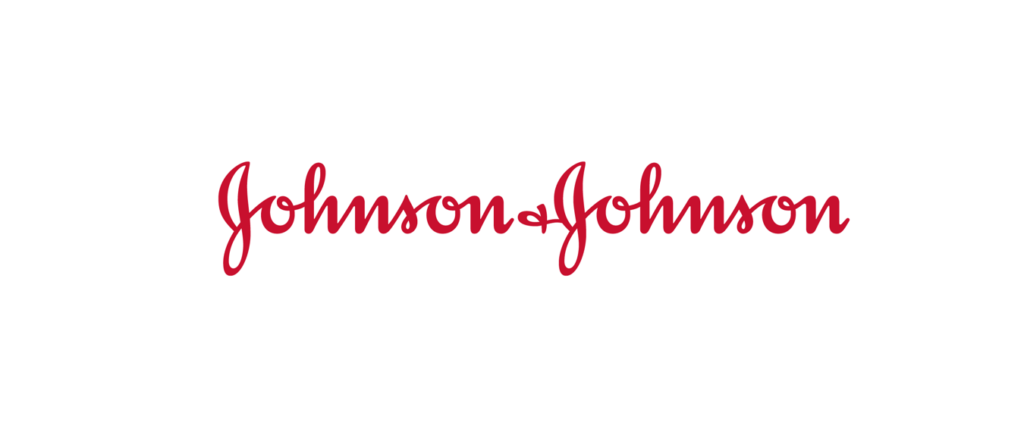
The Foundation includes the Credo, which establishes the values incorporated into the decision-making process . The Credo can be seen in every single office and corner of Johnson & Johnson facilities . The Credo is a reminder of the standards that are upheld in correspondence with the company’s aspirations. The Strategic Principles include the company’s organizational approach, which is a decentralized structure in management for the long term. Lastly, the Growth Drivers are the areas of focus for growth and innovation, which include the Leadership Imperatives of Connect, Shape, Lead, and Deliver. These four Leadership Imperatives are considered the “4 Pillars” of Johnson & Johnson and are the main attributes the company looks for when seeking employment. The company is leadership-driven and needs leaders of employees to act as such. These three components support why Johnson & Johnson’s Strategic Framework is at the core of the business’ continued success for the past 130 years.
Mission and Vision
The mission of Johnson & Johnson is to, “Make diversity & inclusion how we work every day”. The purpose of a mission statement is to outline the foundation of the company’s goals and objectives. This mission is supported by the company’s vision of, “Be yourself, change the world”. Johnson & Johnson’s vision is a broader representation of where the firm plans to go in the future. These two statements validate why the company is listed as #16 of “The Happiest Companies to Work For in 2017”. Johnson & Johnson aspires to bring in natural-born leaders who are comfortable being themselves across a multitude of diverse backgrounds. Being comprised of 130,000 employees, the company wants to advance its unique culture to “spark solutions that create a better, healthier, world”. According to Forbes Patrick Hull, there are 4 essential questions that need to be answered in a mission statement. These four questions include the what, how, whom, and value brought. Johnson & Johnson’s mission is lacking half of these qualities because of how short and simple its statement is. The statement includes the what- diversity, and the value- inclusion; however, the statement does not go into the how or whom it addresses. Yet, one can imply the “how “by working across a range of diverse nations and the “whom” by those included in The Credo (patients, employees, communities, and shareholders). The statement is clear and concise but requires more implications than other traditional missions.
Johnson & Johnson is a company that is constantly pursuing its mission. This can be seen in its “Health for Humanity 2020 Goals”. The company’s “Health for Humanity 2020 Goals” are 15 goals that should be completed in a 5-year term to make “the places we live and work in healthier” across the world. These objectives are already being completed as seen in making and donating more than 160 million doses of medicine to children in underprivileged communities. These actions support the company’s mission by providing medicine to various societies and prioritizing physical well-being. The company’s mission, vision, and goals for 2020 align with The Foundation of the Strategic Framework, by always putting the people first.
Form of Organization
Johnson & Johnson converted from a private to a public corporation in 1944. Converting to a public corporation gave its shareholders and the public more visibility to the operations of the firm. Johnson & Johnson’s information can now be viewed on sources such as the NYSE. According to Zacks Investment Research, “being publicly traded is a two-edged sword”. This statement is due to the visibility that can put the company at a higher risk of failure exposure . If operations are not going as well as planned, this could reflect negatively in the company’s annual report and be used to a competitors’ advantage. Disclosing information that private firms are not required to do can have its perks as well as its downfalls. Shareholders appreciate the creditability as it allows them to access their day-to-day return, but this can also be put into a negative perspective if their return happens to plummet. Fortunately, Johnson & Johnson has had a consistent dividend growth for 55 years, which helps ensure its 2,419 shareholders (valued at $236 billion) that the company is in constant growth.
Besides being publicly traded, there are also advantages and disadvantages to being a corporation. The top three advantages of a corporation include limited liability, the ability to raise more money for investment, and size. Johnson & Johnson optimizes its limited liability and size capacity. Having limited liability is crucial for a large corporation like Johnson & Johnson. Since the company is in the consumer, pharmaceutical, and medical devices markets, it is vital for its owners to have limited losses in the company. This extra protection for its owners is extremely necessary right now with the issuance of lawsuit claims against the company for as much as $417 million. If the owners were liable for all the losses exceeding their investment, the owners may be entirely wiped out by now. Not only could this include the owners’ investment in the company, but it could also include their houses, cars, retirement funds, etc. Johnson & Johnson also leverages its size against competitors in its markets. Since the firm is so massive, it can accumulate enough profit and power every year to invest, acquire, and grow assets in the company.
On the other hand, the top three disadvantages of a corporation include extensive paperwork, double taxation, and difficulty of termination. Johnson & Johnson’s most evident disadvantages are double taxation and difficulty of termination. Since the company is a corporation, it is required to pay taxes twice: first, before it can distribute its income as dividends, and second, once the shareholders receive the dividends. Double taxation decreases the original net income that the firm annually earns. However, Johnson & Johnson acquires enough income to steadily grow every year, even with being taxed twice. It is almost impossible for the company to terminate now that it has expanded worldwide. The main downfall of impossible termination is if the company goes into large sums of debt, and ends up abandoning its employees as a result. The closing of the company would devastatingly leave over 130,000 people unemployed. Therefore, the firm needs to ensure profitable growth every year. Luckily, bankruptcy should not be a problem for Johnson & Johnson anytime soon, as it is currently one of the two AAA-rated companies in the United States for exceptional credit. Understanding the advantages and overcoming the disadvantages of being a corporation is why Johnson & Johnson has been so successful the past 130 years. The execution of its organizational form corresponds with the Strategic Principles in the Strategic Framework by managing for the long term.
Organization Size and Scope
The most recent data of 2017 Second-Quarter Results details Johnson & Johnson to currently have approximately 132,500 employees. These 132,500 employees are distributed among 250 different operating units with over a dozen research facilities in North America, Europe, Asia, and the Middle East, to touch the lives of over a billion people every day, throughout the world. The company operates on a multi-divisional organizational structure , which is the most common organizational structure of large companies with multiple business units. The 250 operating units are restructured to incorporate leadership designed for each facility. A multi-divisional structure is the best way for Johnson & Johnson to maximize return and results, as the appropriate leadership can focus its expertise on its specific segments and business lines within the company.
Johnson & Johnson accumulated $18.8 billion in sales for Q2 which is up 1.9% versus a year ago. The $18.8 billion sales were broken down by $3.5 billion in consumer, $8.6 billion in pharmaceutical, and $6.7 billion in medical devices. The annual sales revenue of Johnson & Johnson in 2016 was $71.94 billion, and the company is projected to surpass this revenue at $76.1 billion by the end of 2017. The company utilizes its size and scope capacity to extend its services to the rest of the world, which resembles the Connect and Lead of the Growth Drivers in Johnson & Johnson’s Strategic Framework by being a leading provider in the consumer health, pharmaceutical, and medical devices industries.
One crucial element to a successful business is executing proper operational activities. Johnson & Johnson has recently extended its company base to include Supply Chain Management . For example, less than one year ago the Supply Chain Team in Buffalo Grove for major retailer Walgreens Co. started out as a two-person team. Within one year, the team now has over ten members and plans to grow by the year. Supply Chain now makes up 45% of employees working for Johnson & Johnson. Supply Chain has become crucially important to Johnson & Johnson’s Strategic Framework in the Foundation of the Credo. It is essential for the firm to not only allocate its resources efficiently but also environmentally friendly. Given a highly competitive atmosphere, Johnson & Johnson wants to advance its company with eco-friendly sustainability, which provides aid to the community aspect of the Credo.
For Johnson & Johnson to provide eco-friendly resource measures, the company must sustain proper inventory management . One tactic the company uses to handle its inventory is the FIFO valuation method. Johnson & Johnson implements a “first-in, first-out” inventory management approach to ensure proper product chain allocation. This means that the first goods purchased are the first ones sold. The advantage of this method is it reduces the risk of items becoming obsolete or outdated. Since Johnson & Johnson manufactures thousands of products with expiration dates, it is important for the company to use this resource measure when managing its inventory .
When the company produces its primary products, it also tries to implement end-to-end supply chain optimization. The end-to-end tool is used to eliminate as many “middle layers” as possible to increase efficiency and costs. The company is partnered with approximately 80,000 suppliers, broken down into 30 categories and grouped into 5 families. Johnson & Johnson has enrolled in the “Sustainable Procurement Program” to focus on supplier efficiency with regulatory system assessments. The hope for the company is to become as efficient, effective, and eco-friendly as possible. In 2016, 58% of packaging, 46% of marketing materials, and 61% of furniture were derived from forest materials.
Johnson & Johnson’s resource process begins with obtaining the raw materials and components needed for product configuration by outsourcing from one of its 80,000 suppliers. Once the materials are received, the product is created by one of its manufacturing plants worldwide. The product is sorted in a case, that is then put with others onto a pallet. The pallet is then shipped by truck, boat, or airplane to one of the major 14 distribution centers. From the distribution center, the product’s case is pulled from the pallet and then shipped to the customer warehouse distribution center. The customer distribution center then receives the products and ships them to the appropriate store locations, which finally sells the product to the end consumer.
As an example, Johnson & Johnson sources its raw materials for its 8 Hour Tylenol 24 count pack from its supplier, produces the pack at its manufacturing plant in Puerto Rico, then ships by boat or airfreight to its three major US consumer distribution centers located in Tobyhanna PA, Mooresville IN, and Fontana CA. The distribution center then sends the product to Walgreens’ two distribution centers located in Woodland CA and Marino Valley CA. Walgreens’ warehouse distribution centers further ship the product by truck to its brick and mortar store locations nationwide. The distribution center the product ships from is dependent on its proximity to the retail store. Once receiving the product from the closest geographical warehouse distribution center, the store places the product on the shelf, for a Walgreens customer to purchase.
Organizational Structure
Since the company has vastly widened geographically to 250 different operating units, it makes sense for Johnson & Johnson to delegate more freedom to its managers and employees in each unit. Johnson & Johnson’s facilities incorporate a decentralized structure with more empowerment for its workers in various levels of management . Implementing a decentralized structure allows each operating unit to adapt to the needs of the people in each differing location. In a decentralized structure, authority is delegated down the organizational chain. Since Johnson & Johnson is so massive with over 130,000 employees, the pyramidal structure is also quite tall. Having a tall organizational structure means that there are various levels of management and reporting relationships. Generally tall, decentralized structures are inefficient because of the lack of communication across multiple segments and levels. However, Johnson & Johnson is one of the few large companies that has used this structure to its advantage by adapting to the local needs in proximity to each operating unit. The company’s diversified organizational structure is affiliated with the Strategic Principles of Johnson & Johnson’s Strategic Framework of a long-term decentralized organizational approach.
The two main advantages of a decentralized structure include higher morale and faster decision-making. Imagine if a low-level manager had to ask its boss’ boss’ boss’ boss for approval on a decision. Increasing empowerment in its various levels of employees improves time management and provides employees with higher levels of satisfaction. The two main disadvantages of a decentralized structure include less top-management control and a weakened corporate image. However, these two disadvantages are in fact advantages for Johnson & Johnson as the company leverages its decentralized structure for a happier working environment which increases its corporate image to the public. It can also be assumed that Alex Gorsky, CEO of Johnson & Johnson, does not want nor has the time capacity to oversee 130,000 employees on his own. Instead, the decentralized structure includes multiple operating units that have different functional and divisional groups within.
For example, the Customer Focused Team in Buffalo Grove IL, is divided between Health & Wellness and Beauty & Personal Care. Within each division, there are different functions and responsibilities for each employee. Both divisions have Customer Development Managers that oversee specific brand lines, as well as Supply Chain Representatives that have the task of managing inventory allocation for specific brand lines.
Financial Condition
Johnson & Johnson is labeled as one of, “The 10 Most Profitable American Companies in the Fortune 500”. For a company to be profitable, it must sustain substantial cash flow. One of the most relevant indicators of wealth in financial statements is the statement of cash flows . Johnson & Johnson’s statement of cash flows provides crucial insight into the success of the company’s profitability . The statement of cash flows is segmented by operating, investing, and financing activities. Currently for Q2 2017, Johnson & Johnson has $5.77 billion, -$12.25 billion, and -$1.92 billion in operating, investing, and financing activities, respectively. These numbers in Q2 2016, were $4.99 billion, $1.32 billion, and -$1.46 billion in operating, investing, and financing activities, respectively. When comparing the differing activities, the operating and financing segments seem relatively similar to the prior year. However, there is a huge difference between Q2 2017 investing activities (-$12.25 billion) versus prior Q2 2016 investing activities ($1.32 billion). This can be explained by Johnson & Johnson’s quarterly report. In Q2 2017, Johnson & Johnson finalized the acquisition of Actelion Ltd. for $30 billion in cash. The acquisition of a leading biopharmaceutical company such as Actelion Ltd. is substantial compared to the prior-year acquisition of Vogue International LLC for $3.3 billion in cash.
Both purchases appear in the investing activities section under the statement of cash flows. The range of purchases is the main reason behind the difference in investing activities versus the prior year. Nevertheless, this is not a bad sign to be negative in investing activities. In fact, it is a positive sign to see a negative in the investing portion of the statement of cash flows because growing companies spend increased amounts of money on new assets. In this case, Johnson & Johnson bought out Actelion, which is an immense contribution to the company’s assets. For a company to grow substantially, it must acquire more power and ownership in the market. In this case, Johnson & Johnson acquired a much larger company this quarter versus the prior year which will propel growth and profit in the future.
In regard to the other two sections of the statement of cash flows with operating and financing activities, there is not a significant difference between the two quarters. Both sections indicate positive, stable growth for the company. The operating activities increased by $.78 billion versus the prior year. It is always a good sign for the company to attain positive operating activities. This data showcases that Johnson & Johnson is making money off its goods and services. The increase can be explained by new technology and the entrants of new products. In Q2 2017, new products DARZALEX® (daratumumab) and IMBRUVICA® experienced rapid growth, resulting in the increase of operating activities for the quarter. On the other hand, financing activities can fluctuate on positivity versus negativity. The company’s financing activities of Q2 2017 are similar to Q2 2016 in the respect of both requiring the payment of cash dividends and the repurchase of common and preferred stock. This payment and repurchase allow Johnson & Johnson to diminish its debt and advance capital. Having sustainable flows of cash corresponds to Deliver of the Growth Drivers in the Strategic Framework by delivering the best results and maintaining a stable statement of cash flows.
Industry/Competitive Environment
With a highly competitive industry, Johnson & Johnson is focused on the segment that contributes the most to the overall success of the company . Johnson & Johnson’s pharmaceutical industry has reported continued growth for Q2 2017 and amounted to roughly 46% of the company’s total revenue. Pharmaceuticals has continued to account for the largest segment of revenue within the company for the past three years. In the pharmaceutical industry, Johnson & Johnson’s three main competitors include Pfizer, Novartis, and Eli Lilly & Co. Considering the pharmaceutical business includes more than two major competitors owning a significant market share, Johnson & Johnson is considered an oligopoly. An important characteristic of oligopolies is the strategic interdependence between competitors. This statement means that any change in one influences the other- especially when it comes to products or prices. Johnson & Johnson, Pfizer, Novartis, and Eli Lilly & Co create similar medicines designed to cure and treat specific diseases. Therefore, price reliance is not as much of a focus as the differentiation of advantages and benefits associated with its products. Each company heavily relies on innovation within its own laboratories to outdo rival firms. Introducing new products to the pharmaceutical market can heavily impact competitor profits. One way these four oligopolies expand their market share in the industry is by using their size capacity to facilitate large research and development budgets to create new drugs and medicines.
Over the course of the past ten years, Johnson & Johnson has increased its research and development budget, giving them a competitive advantage over the other three firms. This supports Johnson & Johnson’s Credo to support its doctors and patients in the Foundation section of its Strategic Framework. According to Endpoints News, Johnson & Johnson is #2 on the list of “The 15 Top R&D Spenders in the Global Biopharma Business” in 2016. The company’s research and development budget has increased significantly over the years, where their budget originally was lacking behind competitors at $6.4 billion in 2005. Ever since Johnson & Johnson has made it a priority to improve innovation by increasing the budget. As of 2016, the company’s budget spend was $9.1 billion, followed by #3 Novartis at $8.4 billion, #4 Pfizer at $7.8 billion, and lastly #9 Eli Lilly at $5.4 billion. Allocating more money on research and development provides Johnson & Johnson with a competitive advantage by enabling the company to create more product differentiation with the entrance of new products.
The competitive advantage of an increased research and development budget is shown in Johnson & Johnson’s announcement to introduce at least ten new products by 2019 that each have the potential to generate over $1 billion in sales. The new products also include more than 40 line extensions of existing and new medicines. Another competitive advantage Johnson & Johnson has over competitors Pfizer, Novartis, and Eli Lilly & Co, is the protection of its diversified product portfolio . While the company’s competition has other various pharmaceutical products, Johnson & Johnson has much more intellectual property on its inventions. In “Top 300 Organizations Granted U.S. Patents in 2016”, Johnson & Johnson had 932 patents, whereas Pfizer had 152, Novartis had 247, and Eli Lily did not even make the list at less than 110 patents. The competitive advantage Johnson & Johnson gains from obtaining the most patents for the recent year is its exclusivity to create, use, and sell its products for up to twenty years. There is a direct relationship between its research and development budget with its intellectual property. By prioritizing a larger emphasis on research and development, Johnson & Johnson can produce more innovative processes and patent them, giving the company a step ahead of its competition in the marketplace.
One promise Johnson & Johnson makes time after time is quality assurance. The company strives to achieve the most efficient yet effective products as displayed in Deliver of the Growth Drivers in the Strategic Framework. One way the company executes this is by segmenting its market. It creates products for all ages, genders, and races. It targets each segment by providing a solution to a particular need. For example, teenagers are prone to have more acne- so Johnson & Johnson create products specifically designed for acne treatment and launches “solvemyacne” on its Neutrogena website. “Solvemyacne” includes a personalized questionnaire for a teenager to fill out that ultimately recommends a suitable regimen. This segmentation can be seen across multiple markets, but one market the company is continuously trying to capture and deliver to is its mothers.
Johnson & Johnson assumes that mothers are willing to go the extra mile to provide the best care for their children as stated in their Johnson’s® Baby mission: “We’re helping moms and dads like you safely care for your babies. We know you don’t want to take any risks”. Therefore, Johnson & Johnson, owner of Johnson’s® Baby, creates products of premium quality for those mothers that want the best for their child. The company manufactures all the necessary products a mother may want to be created with the gentlest ingredients. This is supported by “Johnson’s® 5-Step Safety Assurance Process” which constantly tests and evaluates its formula ingredients. The company’s product line contains baby shampoos, oils, body washes, wipes, powders, lotions, etc. Johnson & Johnson knows mothers will pay for the premium product, and therefore designs its products to include the purest, eco-friendly, non-chemical ingredients, that are proven to be the safest and least harmful to children.
Since Johnson & Johnson labels its products to maintain the “highest standards”, its prices reflect this as well. Johnson’s® Baby products are set at a premium yet affordable price, usually higher than private-label or other generic brands. The company utilizes its scientific development and research to provide the safest products while still sustaining an affordable price. Known as cost-based pricing, Johnson’s® Baby products require higher retail prices due to increased material costs associated with better quality. An example of this can be seen with Johnson’s® Baby Head-to-Toe Wash Original Formula 15 oz priced at $5.49 on Walgreens.com, versus Walgreens private-label brand Well Beginnings Baby Wash 15 oz priced at $3.99. The difference in pricing between the private-label brand and the name brand is evident, but not extensive. The company also captures the mother market by using psychological pricing, which sets its product at price points of .49 or .99. This deceives the mother into thinking she is getting the item for $5 when $5.49 versus $5.50 is essentially the same price. However, if the pricing was $5.50 instead, the orders would not be sufficient as the mother then perceives the price as more expensive at $6.
Johnson & Johnson guarantees product placement with its Johnson’s® Baby products to further incentivize mothers to purchase its items. First, the company confirms its products are readily available in the baby section of every large major retail store. These stores include nationwide locations of Walgreens, CVS, Rite-Aid, Kroger, Target, and Walmart. The company ensures its products are an option for the mother. To begin with, the company pushes for product purchasing by implementing on-shelf availability. The company negotiates thousands of dollars to place its baby care products at eye level and within reach on the shelf, for both the mother and the child. This product placement is essential to its marketing technique. By placing the product at eye level for the mother, it is the first baby brand the mother looks at when debating a purchase. Secondly, by placing the product at eye level for the child, the child is then able to grab the product and ask his/her mom to buy it. Allocating on-shelf availability in an accessible manner motivates the mother to purchase the product, whether that be by the decision herself or the pressure from her child.
Although Johnson & Johnson’s pricing is at a reasonable premium level, it allows for the expense of discounts and bundles. The markup on pricing gives the company wiggle room to promote its products at lower prices. Promotions include BOGOs (buy one get one), coupons, or FSIs (free-standing insert). All three promotions lessen the purchasing prices of the items. If vendors expense a promotional spend, the price can be less than the generic brand. This can be seen with the same Johnson’s® Baby Head-to-Toe Wash Original Formula 15 oz priced at $5.49 that currently has a $2 off coupon. This coupon brings the retail price down to $3.49, which is less than the generic Walgreens Well Beginnings Baby Wash 15 oz priced at $3.99. In this case, Johnson’s® Baby is utilizing a high-low pricing strategy, where it is cheaper to buy the name brand than to buy the generic brand when on promotion. Promoting discounts and deals builds a relationship that returns mothers back to the Johnson’s® Baby brand and stimulates growth in the company.
Summary and Conclusion
As shown, Johnson & Johnson continues to outpace the market by delivering maximum benefit across the globe. From the organization’s mission to its size and structure, Johnson & Johnson has proven to be one of the leading healthcare providers in the consumer, pharmaceutical, and medical devices industries. Back in 1866, brothers Robert, James, and Edward Johnson set the foundation of what was at the time small family business. Today, this business has expanded worldwide and makes an impact on more than a billion lives every day. This advancement of Johnson & Johnson for the past 130 years can be attributed to its core Strategic Framework of the Foundation, Strategic Principles, and Growth Drivers for ultimate success.
Related Posts:
- Case Study on Corporate Governance: Satyam Scam
- Case Study of Nike: Building a Global Brand Image
- Case Study: Success Story of Pfizer Inc
- Case Study: American Express "Do More" Advertising Campaign
- SWOT Analysis of Coca Cola
- Corporate Restructuring Exercises by Procter & Gamble (P&G)
- Case Study: L'Oreal International Marketing Strategy
- SWOT Analysis of Volvo
- The Leveraged Buy-out Deal of Tata & Tetley
- Case Study: L'Oreal Global Branding Strategy
Leave a Reply Cancel reply
Your email address will not be published. Required fields are marked *
Johnson and Johnson Crisis Management Case Study
Effective crisis management is a crucial aspect of maintaining a company’s reputation and mitigating potential damage during challenging times.
One company that exemplifies successful crisis management is Johnson & Johnson (J&J), a renowned multinational pharmaceutical and consumer goods corporation.
In this case study, we delve into a significant incident that tested J&J’s crisis management capabilities—the Tylenol cyanide poisoning incident in 1982.
Through Johnson and Johnson Crisis Management Case Study , we gain valuable insights into their strategic approach, their commitment to public safety, and their efforts to rebuild trust and brand reputation.
Through this examination, we can extract valuable lessons and best practices for organizations facing their own crisis situations.
Join us as we explore the Johnson & Johnson crisis management case study and uncover the keys to effectively navigating a company through turbulent times.
Background of Tylenol cyanide poisoning incident in 1982
One company that exemplifies successful crisis management is Johnson & Johnson (J&J), a renowned multinational pharmaceutical and consumer goods corporation. In this case study, we delve into a significant incident that tested J&J’s crisis management capabilities—the Tylenol cyanide poisoning incident in 1982.
This tragic event sent shockwaves through the nation and posed a severe threat to J&J’s brand reputation. However, it was the company’s swift and decisive actions that not only saved lives but also set a new standard for crisis management in the business world.
It all began when several individuals in the Chicago area tragically lost their lives after consuming Tylenol capsules that had been tampered with and laced with cyanide.
The severity of the crisis stemmed from multiple factors.
Firstly, the loss of human lives was a tragic and deeply unsettling event, leaving communities in mourning and creating a climate of uncertainty surrounding the safety of consumer products.
Secondly, the incident struck at the core of J&J’s reputation as a trusted healthcare brand. Tylenol, one of their flagship products, was synonymous with reliability and had become a household name. The tampering incident threatened to tarnish J&J’s reputation for quality and safety, potentially leading to a significant decline in consumer trust.
Furthermore, the crisis had the potential to have far-reaching consequences beyond the immediate incident. It raised concerns about the safety of over-the-counter medications as a whole, casting doubt on the reliability of an entire industry.
The impact of the crisis on J&J’s reputation cannot be understated. It was a defining moment that tested the company’s values, credibility, and ability to navigate through a crisis.
How J&J responded to this immense challenge would determine whether they could regain the trust of consumers, rebuild their brand, and serve as a benchmark for crisis management in the corporate world.
Johnson and Johnson Crisis Management Strategy
Here’s are main features of J&J crisis management stragegy:
Swift response and communication
One of the key pillars of Johnson & Johnson’s crisis management strategy during the Tylenol cyanide poisoning incident was their swift response and effective communication. Recognizing the urgency of the situation, J&J acted promptly to address the crisis and mitigate its potential impact on public safety and their reputation.
Upon learning about the tampering incident, Johnson & Johnson made the immediate decision to recall all Tylenol products from store shelves nationwide. This recall was an unprecedented move, as J&J prioritized public safety over financial considerations. By swiftly removing the potentially contaminated products from the market, J&J demonstrated a commitment to protecting their consumers and reinforcing the trust that had been shaken.
In addition to the recall, J&J proactively communicated with the public, media, and relevant stakeholders. They held press conferences to provide regular updates on the situation, sharing transparent information about the incident, the recall, and the measures being taken to ensure public safety. This open and honest communication strategy helped to establish J&J as a responsible and accountable company, committed to resolving the crisis and protecting the well-being of their customers.
Moreover, J&J collaborated closely with law enforcement agencies and regulatory bodies throughout the investigation. By actively cooperating with authorities, they demonstrated a commitment to holding those responsible for the tampering accountable and restoring public confidence in the safety of their products.
J&J’s decision to recall Tylenol from store shelves nationwide
One of the most significant actions taken by Johnson & Johnson during the Tylenol cyanide poisoning incident was their decision to recall Tylenol products from store shelves nationwide. This recall was a bold and unprecedented move that showcased J&J’s commitment to public safety and their determination to address the crisis head-on.
Recognizing the potential danger posed by the tampered Tylenol capsules, J&J prioritized the well-being of their consumers over any financial implications. Instead of limiting the recall to specific regions or batches of products, they took the proactive and decisive step of recalling all Tylenol products across the United States. This bold decision demonstrated a commitment to protecting the public and preventing further harm.
Transparent communication: public statements and press conferences
Johnson & Johnson (J&J) understood that keeping the public informed and involved was crucial to rebuilding trust and maintaining their reputation as a responsible and accountable company.
J&J promptly issued public statements to address the situation, providing accurate and up-to-date information about the tampering incident and the steps they were taking to ensure public safety. These statements were widely disseminated through various media channels, ensuring that the public had access to the most current information directly from the company.
Furthermore, J&J held press conferences to communicate directly with the media and the public. These press conferences served as platforms for J&J executives and spokespersons to address concerns, answer questions, and provide reassurance. By openly facing the media and engaging in transparent dialogue, J&J demonstrated their commitment to accountability and their willingness to address the crisis head-on.
Cooperation with law enforcement and regulatory agencies
Johnson & Johnson (J&J) prioritized collaboration and cooperation with law enforcement and regulatory agencies during the Tylenol cyanide poisoning incident. Recognizing the need for a comprehensive investigation and the importance of working with authorities, J&J actively engaged with these entities to address the crisis effectively.
J&J immediately reached out to local law enforcement agencies, such as the FBI, and regulatory bodies, including the Food and Drug Administration (FDA). They provided full cooperation, sharing any relevant information and evidence to aid in the investigation. By partnering with these agencies, J&J demonstrated a commitment to finding the culprits responsible for the tampering and ensuring justice was served.
The collaboration with law enforcement and regulatory agencies served multiple purposes. Firstly, it helped expedite the investigation process, leveraging the expertise and resources of these entities to identify the source of the tampered Tylenol products. This cooperation was essential not only for resolving the immediate crisis but also for preventing any future incidents of a similar nature.
Secondly, by actively engaging with authorities, J&J showcased their commitment to public safety and adherence to legal and regulatory requirements. This collaboration sent a clear message that J&J was not only focused on mitigating the immediate crisis but also on preventing any potential threats to consumer well-being.
Introduction of tamper-evident packaging to prevent future tampering incidents
Following the Tylenol cyanide poisoning incident, Johnson & Johnson (J&J) took proactive measures to enhance product safety and prevent future tampering incidents. One of the key steps they implemented was the introduction of tamper-evident packaging, a groundbreaking innovation in the pharmaceutical and consumer goods industry.
Tamper-evident packaging is designed to provide visible indicators of tampering or unauthorized access to a product. J&J recognized that by incorporating such packaging, they could provide consumers with an extra layer of assurance and instill confidence in the integrity of their products.
The new packaging featured several innovative elements, such as foil seals, blister packs, and other tamper-resistant mechanisms. These measures made it visibly evident if a product had been tampered with, allowing consumers to easily identify any potential risks and avoid using compromised products.
By introducing tamper-evident packaging, J&J demonstrated their commitment to learning from the crisis and proactively addressing the vulnerabilities that had been exposed. The implementation of this new packaging was not only a response to the immediate incident but also a long-term solution to safeguard consumer safety and prevent future tampering incidents.
Collaboration with industry and government bodies to establish safety standards
J&J actively engaged with industry associations, regulatory agencies, and other relevant stakeholders to develop and promote stringent safety standards. They collaborated with organizations such as the Consumer Healthcare Products Association (CHPA) to share best practices, exchange information, and develop industry-wide guidelines for product safety and tamper prevention.
Furthermore, J&J worked closely with government bodies, including the Food and Drug Administration (FDA), to establish robust regulations and protocols for product packaging, labeling, and security. They actively participated in discussions and provided valuable insights based on their experience during the crisis, contributing to the development of comprehensive safety standards.
Through these collaborative efforts, J&J played an instrumental role in shaping industry norms and regulatory frameworks. They shared their expertise, lessons learned, and innovative solutions to raise the bar for product safety across the pharmaceutical and consumer goods sectors.
Compensating victims and affected parties
J&J established a compensation fund to assist victims and their families. This fund aimed to cover medical expenses, counseling services, and other related costs incurred as a result of the tampering incident. By offering financial support, J&J demonstrated their willingness to take responsibility for the harm caused and to help alleviate the burdens faced by those affected.
Moreover, J&J engaged in direct communication and outreach to affected parties, expressing empathy and understanding for the challenges they endured. This personalized approach helped to build trust and foster a sense of care and support, showing that J&J was committed to assisting and standing by those affected by the crisis.
Offering refunds and product exchanges to restore consumer confidence
As part of their efforts to rebuild trust and restore consumer confidence after the Tylenol cyanide poisoning incident, Johnson & Johnson (J&J) implemented a customer-focused approach by offering refunds and product exchanges.
Understanding that consumers may have concerns about the safety of their purchased Tylenol products, J&J took proactive measures to address these concerns. They established a refund and exchange program, allowing customers to return any Tylenol products they had purchased, no questions asked. This initiative provided consumers with the opportunity to receive a refund or exchange their products for alternative J&J offerings.
Reintroduction of Tylenol to the market with improved packaging and safety measures
J&J invested substantial resources in developing and implementing enhanced packaging and safety measures for Tylenol products. They introduced tamper-evident packaging, which included innovative features such as foil seals, blister packs, or other mechanisms designed to clearly indicate whether the product had been tampered with. These visible deterrents provided consumers with a sense of confidence and security, knowing that they could easily identify if the product’s integrity had been compromised.
By reintroducing Tylenol with improved packaging and safety measures, J&J demonstrated their dedication to learning from the crisis and implementing tangible solutions. This proactive approach showed that J&J had taken concrete steps to address the vulnerabilities that had been exposed and to prevent similar incidents from happening again.
Recommendations for other organizations facing potential cirisies
Organizations facing potential crises can learn from J&J’s experience and consider the following recommendations:
- Proactive risk assessment: Conduct regular risk assessments to identify potential vulnerabilities and develop strategies to address them. This includes evaluating supply chain security, product packaging integrity, and other areas relevant to consumer safety.
- Crisis management plan: Develop a comprehensive crisis management plan that outlines roles, responsibilities, communication protocols, and steps for rapid response. Regularly review and update the plan to align with changing circumstances and emerging risks.
- Strong internal communication: Establish effective internal communication channels to ensure that all employees are aware of the crisis management plan and their roles during a crisis. This promotes a coordinated response and consistent messaging.
- Regular media monitoring: Implement a media monitoring system to stay informed about public sentiment, detect early signs of potential crises, and respond swiftly to emerging issues. This helps manage reputation and allows for timely interventions.
- Continuous improvement: Embrace a culture of continuous improvement by regularly evaluating and enhancing product safety measures, quality control processes, and crisis management strategies. Learning from past incidents helps strengthen resilience and prevent future crises.
Final Words
Johnson and Johnson Crisis Management Case Study serves as a remarkable case study in crisis management. The swift response, transparent communication, recall decision, cooperation with law enforcement, and prioritization of public safety played pivotal roles in mitigating the impact of the crisis and rebuilding trust.
J&J’s commitment to consumer well-being over financial considerations, introduction of tamper-evident packaging, collaboration with industry and government bodies to establish safety standards, and their focus on preparedness and having a crisis management plan in place are valuable lessons for organizations facing potential crises.
Johnson and Johnson Crisis Management Case Study serves as a reminder that crises can happen unexpectedly, but with a well-prepared and thoughtful approach, organizations can successfully navigate these challenges, rebuild trust, and emerge stronger than before.
About The Author
Tahir Abbas
Related posts.

Nudge Theory in Change Management

Organizational Restructuring Communication to Staff

Examples of Change in the Workplace – A Detailed Insights
- Harvard Business School →
- Faculty & Research →
- October 1982 (Revised May 1992)
- HBS Case Collection
Johnson & Johnson: The Tylenol Tragedy
- Format: Print
About The Author
Stephen A. Greyser
More from the author.
- Faculty Research
LALIGA—From a Soccer Competition Organizer to a Global Player in the Sports and Entertainment Industry
Instructor's note, sport business in the classroom.
- LALIGA—From a Soccer Competition Organizer to a Global Player in the Sports and Entertainment Industry By: Stephen A. Greyser, Kenneth Cortsen and Juan Fuentes Fernández
- Instructor's Note By: Stephen A. Greyser
- Sport Business in the Classroom By: Stephen A. Greyser

S W O T Case Study Johnson & Johnson
Oct 03, 2014
220 likes | 1.33k Views
S W O T Case Study Johnson & Johnson. Background Johnson & Johnson formed in1886 and it released it’s product of note in 1896 The firm branched out in 1919, and was listed on the New York Stock Exchange in 1944
Share Presentation
- johnson johnson
- strategic acquisitions
- launch products
- strategic acquisitions maintained
- johnson johnson formed in1886

Presentation Transcript
SWOT Case Study Johnson & Johnson Background • Johnson & Johnson formed in1886 and it released it’s product of note in 1896 • The firm branched out in 1919, and was listed on the New York Stock Exchange in 1944 • Over the years Johnson & Johnson has grown substantially due to strategic acquisitions such as Neutrogena in 1994 and DePuy in 1998. From 1989 to 1999, the company made 45 such acquisitions of companies and product lines • Today the firm can boast of revenues exceeding $61,897 million during the financial year ending in December 2009 • Johnson & Johnson products fall into three main categories: Pharmaceuticals, Medical Devices & Diagnostics, and Consumer Health care
Johnson & Johnson’s Strengths • A Substantial Marketing Arsenal – Can call upon a network of subsidiaries with significant sales and marketing prowess, as well as expertise in a number of therapy areas. The company possesses a global sales force which serves to attract joint venture possibilities • Strategic Acquisitions –Maintained a stable financial position by utilising cash reserves to finance corporate acquisitions • Product Diversification –The pharmaceutical, Medical Devices & Diagnostics and Consumer Health divisions act to reduce dependence upon any one area and allows a wider range of choice when pursuing opportunities with the greatest growth prospects • Positive Revenue Growth Projections –The potential of an impressive number of new product launches and the promise of achieving forecast sales is said to bode well for Johnson & Johnson
Johnson & Johnson’s Weaknesses • Dependence upon the Success of Launch Products –Many new launch products are vulnerable to the uncertainty of regulatory review • Reliance on Small Molecule Drugs – Small molecules are more impacted by generic competition. Johnson & Johnson’s small molecule drug sales declined in 2008 and are forecast to fall further into 2012. The necessity of finding replacements for billion dollar products as they mature represents an daunting task Johnson & Johnson’s Opportunities • Wide Range of Potential Cross-selling Opportunities –Johnson & Johnson is in a position to strategically develop a myriad of cross selling opportunities. Maximizing its balance between pharmaceuticals, diagnostics, and medical devices could result in increased revenues • Potential to Exploit Biologics Market –The addition of further biologics (e.g. therapeutic proteins, antibodies) to its portfolio can serve as a buffer as small molecule patents expire
S W Johnson & Johnson’s Threats • Dependence on the Success of Launch Products –Many new launch products are vulnerable to the uncertainty of regulatory review, therefore, a reliance upon launch products potentially represents a threat to Johnson & Johnson’s outlook. • Negative Impact of Recent Product Recalls –Johnson and Johnson has had the misfortune of having to recall of more than 40 medicines recently. The company stands to take a hit to it’s reputation, competence and integrity. After analysing their SWOT, Johnson & Johnson now have to come up with an action plan to address/solve the problem they have been addressing O T
- More by User

Add Title. Presentation 1 Legal Discussion: Deed in Lieu of Foreclosure Eric Johnson Holme Roberts & Owen LLP. Case Study: Environmentally Distressed Development Site Kenneth Ho Real Estate Generation, LLC. Legal Issues Concerning Deeds in Lieu of Foreclosure Eric E. Johnson
818 views • 58 slides

Johnson & Johnson Use of Public Key Technology
Johnson & Johnson Use of Public Key Technology. Rich Guida Director, Information Security. Johnson & Johnson. The world’s largest and most comprehensive manufacturer of health care products Founded in 1886 Headquartered in New Brunswick, NJ Sales of $41.9 billion in 2003
306 views • 12 slides

Johnson's domestic violence typology: Implications for intervention programmes
Johnson's domestic violence typology: Implications for intervention programmes. Dr Nicola Graham-Kevan CPsychol University of Central Lancashire ng [email protected]. Overview. Pro-feminist research Gender neutral approaches Johnson Study 1 & 2 Study 3 Conclusions.
866 views • 24 slides
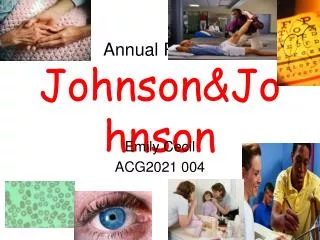
Annual Report Johnson&Johnson
Annual Report Johnson&Johnson. Emily Cecil ACG2021 004. Executive Summary.
498 views • 14 slides

Chapter 26 Simultaneous Equation Models for Security Valuation
By Cheng Few Lee Joseph Finnerty John Lee Alice C Lee Donald Wort. Chapter 26 Simultaneous Equation Models for Security Valuation. Outline. 26.1 Warren and Shelton model 26.2 Johnson & JOhnson AS A CASE STUDY 26.2.1 Data Sources and Parameter Estimations
113 views • 0 slides
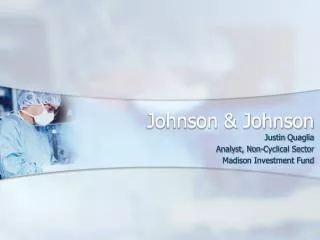
Johnson & Johnson
Johnson & Johnson . Justin Quaglia Analyst, Non-Cyclical Sector Madison Investment Fund. Objective. A stable and strong company that meets all the needs of a stock an investor should have going into a recession
667 views • 27 slides

Fall Zone – A Unique Case
Fall Zone – A Unique Case. Clyde B. Johnson, SR/WA, R/W-URAC, R/W-RAC CardnoTBE & Clyde B. Johnson, Consultant Services, Inc. 515 Wellspring Court Alpharetta, Georgia 30004 [email protected] t (c) 678-350-3675. Back in the day!. Now we have signs that exceed far
288 views • 18 slides

Robert Johnson
Robert Johnson. Group 1 By: Seth Sandhoefner, Scott Durdin, Mary Wheeler, and Alec Osthoff. Robert Johnson-Imagery. 5. 3. 4. Some general info.
831 views • 22 slides
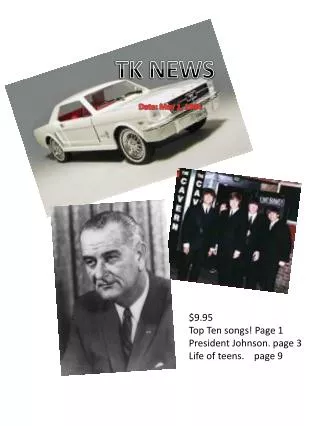
TK NEWS. Date: May 1, 1964. $9.95 Top Ten songs! Page 1 President Johnson. page 3 Life of teens. page 9. Lyndon B. Johnson. Johnson was the 36 th president taking service from 1964–1969 Johnson pushed the Vietnam war to its max from 16,000 to 550,00 in 1963
195 views • 6 slides

169 views • 5 slides

Johnson. Johnson was captured as a young man by the Portuguese and sold into slavery. n Bennett Plantation Anthony labored for 20 years and bought his freedom as well as Mary’s his wife. . He owned 250 acres from headright system used by white gentlemen.
152 views • 1 slides


Lyndon B. Johnson
Lyndon B. Johnson. A fourth-generation Texan, Lyndon B. Johnson (LBJ) entered politics in 1937 as a congressman Johnson admired Franklin Roosevelt who took the young congressman under his wing Johnson became a senator in 1948 and by 1955 he was Senate majority leader.
653 views • 27 slides
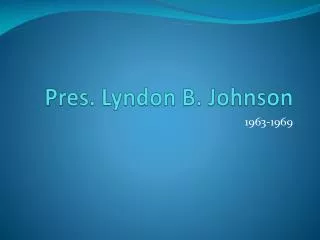
Pres. Lyndon B. Johnson
Pres. Lyndon B. Johnson. 1963-1969. 1963. Pres. Johnson becomes the 36 th President after JFK’s assassination Pres. Johnson pledges support for Pres. Kennedy’s legislative agenda, which included civil rights & education legislation. Important events & bills passed.
424 views • 21 slides

T. G. C. G. T. Z. Y. J. Lundgren. AJ Johnson. J. Ehlert. Cam. Jones. E. Williams. E. Spyhalski. A. Omotoyinbo. Z. Holden. E. Horton. D. Tolkinen. B. Stromback. J. Contreras. S. Christopher. N. Norman. 1. I. Smith. X. T. Yang. J. Tait. A. Johnson. 4. M. Johnson.
206 views • 4 slides
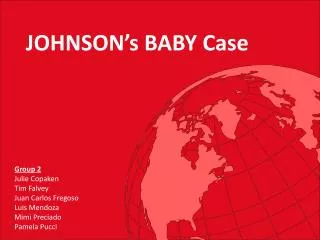
JOHNSON’s BABY Case
JOHNSON’s BABY Case. Group 2 Julie Copaken Tim Falvey Juan Carlos Fregoso Luis Mendoza Mimi Preciado Pamela Pucci. Executive Summary. Johnson´s Baby is seeking to increase penetration and product usage among CD consumers (preferably in the DTT channel)
513 views • 10 slides

The Johnson & Johnson Tylenol Crisis
The Johnson & Johnson Tylenol Crisis. Elise Abramson Stephanie Zhao. Background. Tylenol , Band Aid, Acuvue, Neutrogena , Benadryl , Listerine Est. 1886 by James Wood Johnson, Edward Mead Johnson, and later Robert Wood Johnson First produced antiseptic surgical dressings
1.76k views • 6 slides
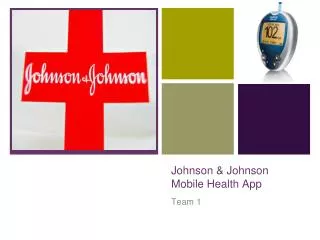
Johnson & Johnson Mobile Health App
Johnson & Johnson Mobile Health App. Team 1. Background. Almost 26 million diabetics in the US Around 370 million diabetics in the world Daily checks of blood sugar levels Estimates project one in three American adults will have diabetes in 2050. Brief Overview. OneTouch Devices
285 views • 10 slides
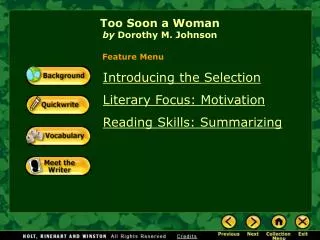
Too Soon a Woman by Dorothy M. Johnson
Too Soon a Woman by Dorothy M. Johnson. Feature Menu. Introducing the Selection Literary Focus: Motivation Reading Skills: Summarizing. Too Soon a Woman by Dorothy M. Johnson. Too Soon a Woman by Dorothy M. Johnson. What if you were left in the middle of nowhere.
1.18k views • 11 slides

Johnson & Johnson. Research indicates that moms go online to get information about their newborn babies. Research also found that babies who are Hispanic represent 25 percent of babies born in the United States. What is the opportunity for Johnson & Johnson?
473 views • 16 slides

- My presentations
Auth with social network:
Download presentation
We think you have liked this presentation. If you wish to download it, please recommend it to your friends in any social system. Share buttons are a little bit lower. Thank you!
Presentation is loading. Please wait.
1 Case Study 19 th August 2004. 2 Johnson & Johnson?
Published by Modified over 8 years ago
Similar presentations
Presentation on theme: "1 Case Study 19 th August 2004. 2 Johnson & Johnson?"— Presentation transcript:

An Introduction NHS Supply Chain

Combating Counterfeiting and Piracy Collaboration Against Corruption David S. Howard Director, Product Protection Global Brand Integrity Johnson & Johnson.

Eaton Business System Overview

“Your full service brand management and fulfillment partner”

Customer Service & Customer Protection in MANSELL

Pepsico CONTENTS MISSION LOGO AND ITS RELEVANCE. COMPANY INVESTORS SOCIAL RESPONSIBILITIES DIVERSITY NEWS QUERIES……????

Vision, Mission & Values

Joseph Van Houten, Ph.D., CSP

Chapter 19 Customer Service McGraw-Hill/Irwin Copyright © 2009 by The McGraw-Hill Companies, Inc. All rights reserved.

Chapter 4 Global Human Resource Management

CSR at Scotiabank Kim Brand Santiago, Chile December 9, 2008.

E-Marketing Plan By: Beth Malmborg. Outline Industry Overview Company Overview/History SWOT Analysis Market Opportunity Analysis –Demand –Segment –Supply.

SUSTAINABILITY DEFINITION

Federal Business Alliance Texas Small Business Procurement Fair - What It Takes to be My Partner - Lee Ann Standish, PMP Vice President / Small Business.

Fifth Third Bank of Central Indiana Join Our Team.

Building Careers for a Lifetime

Strategic Management Process

Industry Profile Pharmaceutical companies produce the drugs that save lives, and prevent illness as the population ages Large Cap pharmaceuticals are.

Abbey Strickland. History 1886 The Johnson brothers founded a company in New Brunswick, New Jersey. Robert Wood Johnson James Wood Johnson Edward Mead.

1. 2 “Caring for the world, one person at a time…inspires and unites the people of Johnson & Johnson.”
About project
© 2024 SlidePlayer.com Inc. All rights reserved.
SustainCase – Sustainability Magazine
- trending News
- Climate News
- Collections
- case studies
Case study: How Johnson & Johnson promotes environmental and social responsibility throughout its supply chain
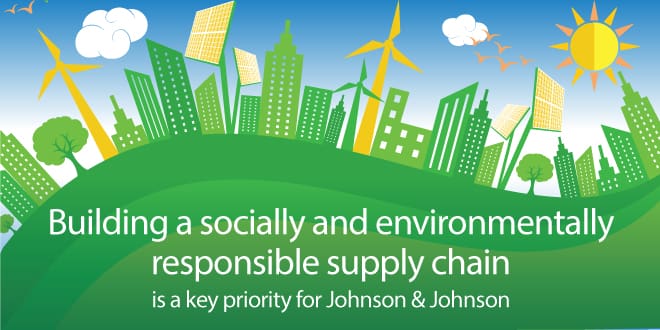
As the world’s largest and most diversified healthcare company, with 134,000 employees in 60 countries, Johnson & Johnson works with over 70,500 suppliers across its three business segments Tweet This! : Consumer, Medical Devices and Pharmaceutical. Building a socially and environmentally responsible supply chain is, thus, a key priority.
This case study is based on the 2017 Health for Humanity Report b y Johnson & Johnson published on the Global Reporting Initiative Sustainability Disclosure Database that can be found at this link . Through all case studies we aim to demonstrate what CSR/ sustainability reporting done responsibly means. Essentially, it means: a) identifying a company’s most important impacts on the environment, economy and society, and b) measuring, managing and changing.

For Johnson & Johnson, creating a sustainable supply chain reduces sourcing risks, protects brand reputation and, most importantly, has comprehensive positive impacts on both society and the environment. In order to promote environmental and social responsibility throughout its supply chain Johnson & Johnson took action to:
- monitor compliance with the Responsibility Standards for Suppliers
- carry out Environment, Health & Safety (EHS) audits
- conduct social audits

Subscribe for free and read the rest of this case study
Please subscribe to the SustainCase Newsletter to keep up to date with the latest sustainability news and gain access to over 2000 case studies. These case studies demonstrate how companies are dealing responsibly with their most important impacts, building trust with their stakeholders (Identify > Measure > Manage > Change).
With this case study you will see:
- Which are the most important impacts (material issues) Johnson & Johnson has identified;
- How Johnson & Johnson proceeded with stakeholder engagement , and
- What actions were taken by Johnson & Johnson to promote environmental and social responsibility throughout its supply chain
Already Subscribed? Type your email below and click submit
What are the material issues the company has identified?
In its 2017 Health for Humanity Report Johnson & Johnson identified a range of material issues, such as product quality, safety and reliability, ethics and compliance, innovation, global public health, workplace safety. Among these, promoting environmental and social responsibility throughout its supply chain stands out as a key material issue for Johnson & Johnson.
Stakeholder engagement in accordance with the GRI Standards
The Global Reporting Initiative (GRI) defines the Principle of Stakeholder Inclusiveness when identifying material issues (or a company’s most important impacts) as follows:
“The organization should identify its stakeholders, and explain how it has responded to their reasonable expectations.”
Stakeholders must be consulted in the process s of identifying a company’s most important impacts and their reasonable expectations and interests must be taken into account. This is an important cornerstone for CSR / sustainability reporting done responsibly.
Key stakeholder groups Johnson & Johnson engages with:
How stakeholder engagement was made to identify material issues
To identify and prioritise material topics, Johnson & Johnson invited more than 1,500 stakeholders to respond to a survey. Stakeholders were asked to rank topics by importance to them and by their potential for social, environmental and economic impact.
What actions were taken by Johnson & Johnson to promote environmental and social responsibility throughout its supply chain ?
In its 2017 Health for Humanity Report Johnson & Johnson reports that it took the following actions for promoting environmental and social responsibility throughout its supply chain:
- Monitoring compliance with the Responsibility Standards for Suppliers
- Johnson & Johnson confirms and monitors suppliers’ compliance with its Responsibility Standards for Suppliers by means of a formal assessment and audit program. Assessments are conducted through EcoVadis – a third-party program. EcoVadis assessments involve an initial screening of supplier performance. Subsequently, the results (a score) play an important role in deciding which suppliers may require an on-site audit.
- Carrying out Environment, Health & Safety (EHS) audits
- follow-up technical visits which include expert training and best practice sharing
- business reviews with direct coaching and guidance
- information provided in the Sustainability Toolkit for Suppliers
- supplier relationship management engagement at category level
- participation in supplier capability-building conferences, webinars and other resources that are available through Johnson & Johnson’s membership in the PSCI
- In 2017, Johnson & Johnson carried out 189 EHS audits and technical visits.
- Conducting social audits
- In 2017, to establish an enterprise-wide framework for addressing human rights in its supply chain, Johnson & Johnson expanded the human rights requirements in its updated Responsibility Standards for Suppliers. In addition, a cross-functional Human Rights Working Group met regularly, guiding and informing the development of Johnson & Johnson’s human rights risk assessment approach and audit program. Johnson & Johnson’s supplier social audit program is scheduled to be fully implemented in 2018. Supplier selection and prioritisation criteria will include results for EcoVadis scores regarding Labour and Business Ethics, location in a country considered high risk for violation of human rights and the supplier category.
Which GRI Standards and corresponding Sustainable Development Goals (SDGs) have been addressed?
The GRI Standards addressed in this case are:
1) Disclosure 308-1 New suppliers that were screened using environmental criteria
2) Disclosure 414-1 New suppliers that were screened using social criteria
Disclosure 308-1 New suppliers that were screened using environmental criteria does not correspond to any SDG.
Disclosure 414-1 New suppliers that were screened using social criteria corresponds to:
- Sustainable Development Goal (SDG) 5 : Achieve gender equality and empower all women and girls
- Business theme: Workplace violence and harassment
- Sustainable Development Goal (SDG) 8 : Promote sustained, inclusive and sustainable economic growth, full and productive employment and decent work for all
- Business theme: Labor practices in the supply chain
- Sustainable Development Goal (SDG) 16 : Promote peaceful and inclusive societies for sustainable development, provide access to justice for all and build effective, accountable and inclusive institutions at all levels
78% of the world’s 250 largest companies report in accordance with the GRI Standards
SustainCase was primarily created to demonstrate, through case studies, the importance of dealing with a company’s most important impacts in a structured way, with use of the GRI Standards. To show how today’s best-run companies are achieving economic, social and environmental success – and how you can too.
Research by well-recognised institutions is clearly proving that responsible companies can look to the future with optimism .
FBRH GRI Standards Certified and IEMA approved Sustainability Course | Venue: London LSE
By registering for the next 2-day FBRH GRI-Standards Certified and IEMA approved Course you will be taking the first step in gaining the many benefits of sustainability reporting .
References:
1) This case study is based on published information by Johnson & Johnson, located at the link below. For the sake of readability, we did not use brackets or ellipses. However, we made sure that the extra or missing words did not change the report’s meaning. If you would like to quote these written sources from the original, please revert to the original on the Global Reporting Initiative’s Sustainability Disclosure Database at the link:
http://database.globalreporting.org/
2) http://www.fbrh.co.uk/en/global-reporting-initiative-gri-g4-guidelines-download-page
3) https://g4.globalreporting.org/Pages/default.aspx
4) https://www.globalreporting.org/standards/gri-standards-download-center/
Note to Johnson & Johnson: With each case study we send out an email requesting a comment on this case study. If you have not received such an email please contact us .
Privacy Overview
Case Studies
- - Presentation Design
- - Report Design
- - Marketing
- - Motion Graphics
- - Interactive Design
- - Design with AI
Johnson & Johnson Presentation
We Are Here To Fulfill All Of Your Design Needs
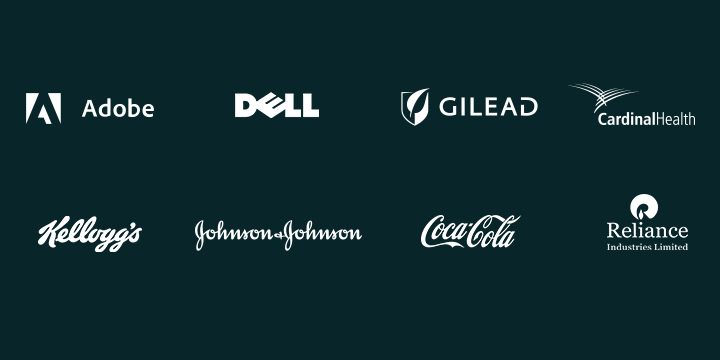
2022 Health for Humanity Report
Employee health, safety & well-being.
Occupational Health and Safety 2018
Promotion of worker health
Work-related injuries
Work-related ill health
At Johnson & Johnson, we take an uncompromising approach to safety in everything we do. We also invest extensively in the health and well-being of our employees; we believe that advancing health for humanity starts with protecting and enhancing the total health—physical, mental, emotional and financial—of our workforce.
We aim to ensure that all our employees around the world, as well as temporary contractors and visitors to our sites, can work safely. Our workplace health and safety programs include adherence to our robust global safety standards, risk assessments, extensive training and communications. We continuously expand health and well-being benefits throughout Johnson & Johnson globally, incorporating new thinking and technologies to help employees achieve their personal mind and body health goals.
Global Employee Safety (%) *
Johan Geerinck
Worldwide Vice President, Environmental Health & Safety, Johnson & Johnson
To reinforce best safety practices, in 2022, we commenced a yearlong global refresher program of our Six Safety Habits framework for all employees in our R&D spaces and supply chain facilities—and those working on construction projects—to reacquaint them with the workplace habits that ensure safety continues to be an essential part of our culture.
Our Six Safety Habits
We learn from both our successes and our failures.
Responsible
Everyone is personally responsible for their safety and the safety of others.
We demonstrate caring and inspire a strong value of safety from the heart.
Transparent
Everyone feels safe to make suggestions and/or share complaints with those who need to know.
Everyone anticipates and actively engages in controlling safety hazards.
We seek diverse perspectives and share safety knowledge within and beyond our four walls.
We constantly reinforce our uncompromising approach to safety through communications to all employees around the world.
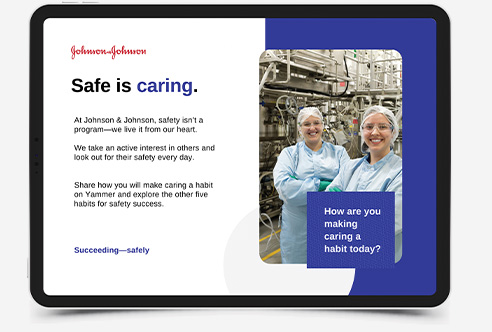
Advancing road safety
Road safety is a key element of our safe working programs, and we continuously seek to improve the safety of our vehicles and, even more importantly, the awareness, vigilance and safe practices of our drivers. In 2022, we took several actions to further improve our driver and fleet safety globally:
- expanded predictive analytics for the majority of our global fleet drivers;
- digitized both global road safety data with online at-a-glance dashboards for effective safety controls and management and also our road safety assurance and audit process;
- standardized our global road safety training on our internal online training platform, accessible to all fleet drivers; and
- distributed a highly reflective inflatable airbag vest to all riders of two-wheeled power vehicles in India to reduce risk of potential injury.

Since 2012, Johnson & Johnson has donated more than 75,000 lifesaving helmets to children in Vietnam.
Beyond safety, we aspire to have the healthiest workforce, inspiring us to continually examine and expand our total health benefits, programs and offerings to support the total well-being of all employees and embed a culture of health throughout Johnson & Johnson. Our healthiest workforce ambition is tracked in our Health for Humanity 2025 Goals annual Healthiest Workforce Score.
Health for Humanity 2025 Goals
Progress in healthiest workforce score.
- 66% of Johnson & Johnson leaders and their managers achieved an ≥80% Healthiest Workforce Score.
The comprehensive well-being portfolio available to Johnson & Johnson employees and their families is reflected in the positive employee perception of organizational support for their total health. In 2022, most global employees believed senior leaders support their health and well-being, as exemplified by the Our Credo Survey results.
In 2022, we again improved our health benefits and programs to support employee health and well-being and rolled out several new initiatives to enhance our robust portfolio of well-being offerings, including:
- Implemented expanded paid parental leave benefits for employees around the world, with 12 weeks of paid leave covering maternal, paternal, adoptive, surrogacy-assisted and foster parents.
- Enhanced the Employee Assistance Programs and CARE (Confidential. Accessible. Responsible. Engaged.) services in select countries, with the intent to introduce additional countries in 2023. The enhanced services connect employees to professional assistance on a broad range of topics. From mental health support to professional life coaching and work-life services (i.e., elder/adult care, travel, childcare, education, pet care, household services and parenting), employees can now easily navigate to the support they need.
- Introduced new virtual mental health resources in the U.S. to support employees and their families, including behavioral support for children, teens and families. Along with other leading companies across industries, we joined Thrive and the Society for Human Resources Management in pledging our continued commitment to prioritizing employee well-being and mental health.
- Expanded travel benefits for U.S. employees and their families, providing reimbursement for travel to receive medical services (inclusive of, but not limited to, reproductive healthcare) not available from any other in- or out-of-network provider within 100 miles of the patient’s home.
Global Activity Challenge
In 2022, we held our seventh 30-day Global Activity Challenge, encouraging our employees to join teams to boost their health by getting moving. Employees were able to select walking, running, dancing, cycling, gardening, practicing yoga or other preferred physical activity, competing against other global teams. The 2022 Challenge engaged more than 33,000 participants in 73 countries, recording more than 7.5 billion steps throughout the Challenge. At the end of the Challenge, Johnson & Johnson donated $50,000 each to Operation Smile and UNICEF.
Energy management
Our enterprise-wide ENERGY FOR PERFORMANCE program helps employees manage their energy capacity so that they can be their best at work and in life. We have consistently expanded the use of this program and introduced virtual courses to continue to deliver this important training during the pandemic. In 2022, 8,872 employees completed ENERGY FOR PERFORMANCE courses.
- Chart Generator
- Scroll to Top
You might be interested in

Message From Our Chairman and CEO

Year in Brief

Reporting Hub

IMAGES
VIDEO
COMMENTS
Case Study: Johnson & Johnson Company Analysis. Founded in 1866 as a family business, Johnson & Johnson now has over 130,000 employees in 60 countries worldwide. What started off as a small, three-person business, the company has now expanded across the globe and was named a "2017 Fortune's Most Admired Company".
Johnson & Johnson Case Study Presented by Rachel Blair Company History The Company Johnson & Johnson was founded in 1886 by Robert Wood Johson and his two younger brothers. Inspired by the need for safe and sanitary healthcare products, the company manufactured the first The ... How to make your branding presentation a success; March 29, 2024 ...
Final Words. Johnson and Johnson Crisis Management Case Study serves as a remarkable case study in crisis management. The swift response, transparent communication, recall decision, cooperation with law enforcement, and prioritization of public safety played pivotal roles in mitigating the impact of the crisis and rebuilding trust.
Case Study on Johnson and Johnson - Free download as Powerpoint Presentation (.ppt / .pptx), PDF File (.pdf), Text File (.txt) or view presentation slides online. Johnson & Johnson is a global healthcare company founded in 1887 that operates in consumer products, medical devices, and pharmaceuticals. It is known for its baby care line started in 1893 with Johnson's Baby Powder.
Johnson & Johnson Business Case Slides -- Robert W. Campbell Award - Free download as Powerpoint Presentation (.ppt), PDF File (.pdf), Text File (.txt) or view presentation slides online. Is there a connection between being socially responsible and building sustainable competitive advantage? Business Case of Johnson & Johnson, 2005 winner of the international Robert W. Campbell Award.
Abstract. In October 1982, Johnson & Johnson was confronted with a major crisis when seven deaths were attributed to poisoned Tylenol. The case reviews the facts as known a week after the incident occurred, and raises a wide range of questions regarding consumer behavior, corporate responsibility, and competitive reaction.
Robert Wood Johnson and then his brother James led the firm for the first 46 years. When Robert Wood (General) Johnson, who was the son of the founder, took over in 1932, the company was well established as a leader in the healthcare field. Though committed to the core strategy, General Johnson brought some new approaches to the business.
During download, if you can't get a presentation, the file might be deleted by the publisher. E N D . Presentation Transcript. SWOT Case Study Johnson & Johnson Background • Johnson & Johnson formed in1886 and it released it's product of note in 1896 • The firm branched out in 1919, and was listed on the New York Stock Exchange in 1944 ...
7 7 Overview of Johnson & Johnson A Broadly Based Health Care Company Johnson & Johnson is the world's most comprehensive and broadly based manufacturer of health care products and services for the consumer, pharmaceutical, and medical & diagnostics markets. The Corporation achieved this leadership by concentrating on a unique form of decentralized management, following the ethical ...
Case Study: Johnson & Johnson. Before the crisis, Tylenol, produced by Johnson & Johnson, was the most successful over-the-counter product in the United States with over one hundred million users. Tylenol was responsible for 19 percent of Johnson & Johnson's corporate profits during the first 3 quarters of 1982.
CASE ANALYSIS: JOHNSON & JOHNSON I. INTRODUCTION "The world's largest health care company"-, that is Johnson & Johnson company. A company that is founded by Robert, James and Edward Johnson in 1886. Johnson & Johnson is a parent company for over 250 subsidiaries. Together, the company's make-up "the Johnson & Johnson family of ...
While the topic of their "The Road to a Vaccine" show is relevant to almost everyone on the planet, Johnson & Johnson was particularly interested in reaching a professional community in the proper context, which made LinkedIn an excellent fit. The audience responded, as a sentiment study around comments during the live-stream found that 97% ...
Subscribe for free and read the rest of this case study. Please subscribe to the SustainCase Newsletter to keep up to date with the latest sustainability news and gain access to over 2000 case studies. These case studies demonstrate how companies are dealing responsibly with their most important impacts, building trust with their stakeholders (Identify > Measure > Manage > Change).
We Are Here To Fulfill All Of Your Design Needs. - Describe your project requirements and objectives. - Specify the desired design style or aesthetic. - Let us know the target audience or market for your design. - Outline any specific branding guidelines or existing assets to be incorporated. - Share your project timeline and any budget ...
Cautionary statement. These webcasts, presentations and transcripts contain "forward-looking statements" as defined in the Private Securities Litigation Reform Act of 1995 regarding, among other things, future operating and financial performance, product development, regulatory approvals, market position, expenditures, impact of acquisitions and dispositions, business strategy and ...
66% of Johnson & Johnson leaders and their managers achieved an ≥80% Healthiest Workforce Score. On track. The comprehensive well-being portfolio available to Johnson & Johnson employees and their families is reflected in the positive employee perception of organizational support for their total health. In 2022, most global employees believed ...